Bibliography
The bibtex and ris files of Claudia Westermann's academic publications, including abstracts and links to open versions of many publications, are available for download from the LITRA server:
Claudia Westermann bibliographic data January 2025
The bibliography files can be imported into reference managers, such as JabRef, Mendeley, Zotero and Endnote.
Selected Publications
Selected papers from the 60th Anniversary Meeting of the American Society for Cybernetics “Living Cybernetics Playing Language” Edited by Claudia Westermann
Editorial: Conversations on Four Cybernetic Approaches to Embracing Uncertainty
https://constructivist.info/20/2
Founded in 1964, the American Society for Cybernetics (ASC) has been influential in the resurgence of cybernetics as second-order cybernetics. Under the overarching theme “Living Cybernetics Playing Language,” the 60th Anniversary Meeting, held in June 2024 in Washington DC, encouraged participants to reflect on cybernetics in everyday contexts, ranging from academic research to the building of communities. Stretching over five days, the conference included more than eighty, mostly participatory, sessions.
The most recent issue of Constructivist Foundations contains four target articles that emerged from this conference, in addition to five to seven peer commentaries and the response of the authors to these commentaries. This set of conversations can be seen as case studies of cybernetic practice and diversity. And yet, as the study of the four target articles and the related commentaries show, in their embrace of uncertainty, the authors share a particular technicity in which formation and reflexivity become intertwined and co-evolve. In its engagement with contemporary challenges, cybernetic technicity introduces recursive links, setting relations across boundaries. As the collection of conversations shows, contemporary cybernetic practice, through varied approaches, is a living tradition of enacting open futures.
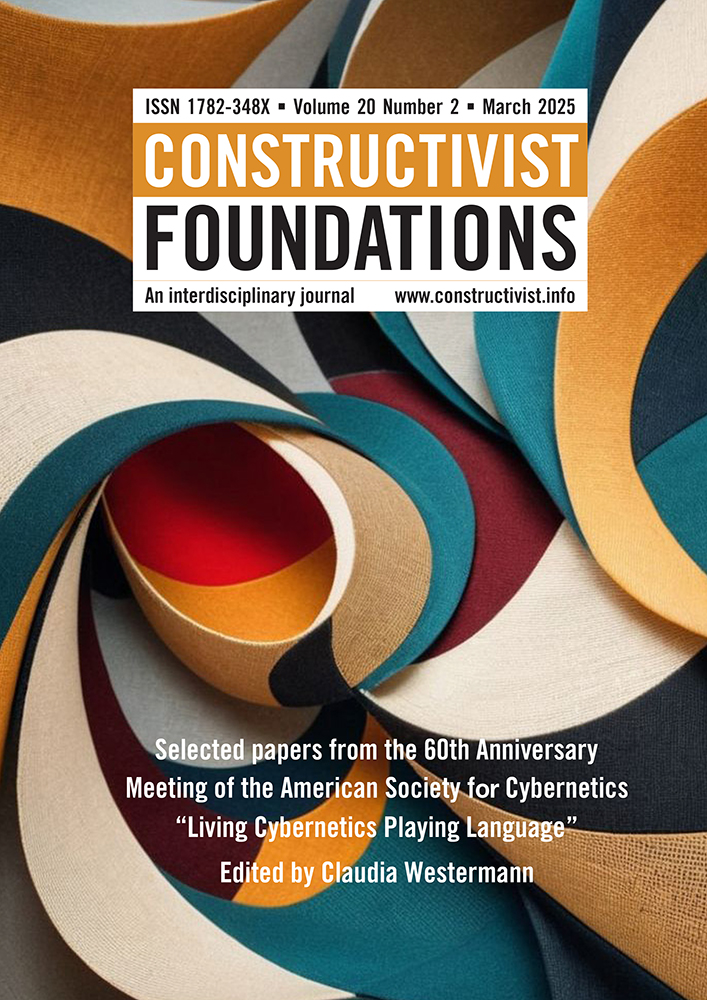
Cover: Cybernetic Neoconstructivism #16 © 2025 Collaboration of the Art, Media, and Cybernetics (AMC) working group at the American Association of Cybernetics (ASC) · AI-Generative Neoconstructivism. Courtesy of the AMC working group.
A Courtyard Conversation, or a zoetological approach to the thinking of things
by Claudia Westermann, Yiping Dong, and Lei Feng
A preprint of the paper is available via the researchgate platform.
Inserted into the entrance to a small courtyard inhabited by four families in Haiyan village, Kunming, China, the work Symphony of the Everyday-Sunset Sonata employs subtle interventions in the form of light, sound and kinetic objects to reveal the aesthetic dimension of everyday objects and materials. Technology is often seen to be in competition with heritage and tradition-frequently threatening it to the point of elimination for a new, smarter world. Symphony of the Everyday-Sunset Sonata, however, suggests that technology can be employed to spark a conversation on the meaning of heritage in everyday life. Grounded in cybernetic conversation theory, the installation uses technology to serve aesthetic experience. Symphony of the Everyday-Sunset Sonata reveals the role of architecture as a means of constructing an enriched life and renders the objects and materials that make up a village household's everyday tangible in their aesthetic dimension. Activated by the movement of the visitors, playing in the presence of the setting sun, the kinetic objects and their sounds engage in a new conversation on the possibilities of technology to nurture a community's heritage and values. The presentation contextualizes the installation Symphony of the Everyday-Sunset Sonata, linking Gordon Pask's concept of conversation and Roger T. Ames' zoetology, a term conceived to emphasize the particular dynamics of traditional Chinese philosophy. This is a preprint of a paper to be published in the RSD13 proceedings.

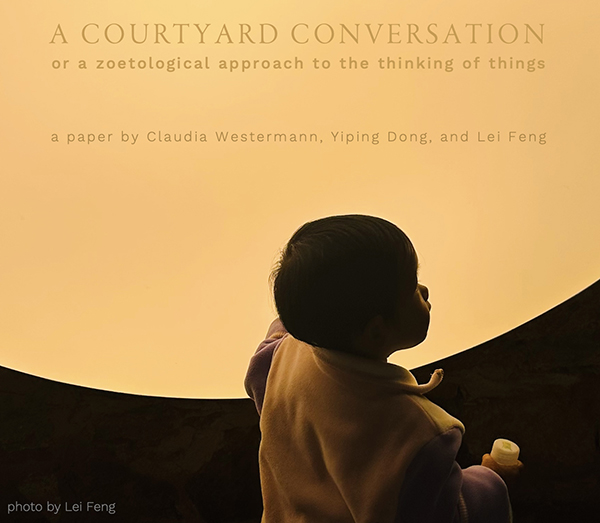
Editorial: Rethinking research with methodologies of art practice
by Claudia Westermann
Technoetic Arts, Volume 22, Issue 1, June 2024, pp. 3–7 (open access)
This issue of Technoetic Arts: A Journal of Speculative Research encompasses eight articles by artists and scholars from around the globe who engage with methodologies of art practice within research that reflects on technological and ecological change, contributing to the discourse on the inclusion of subjective experience in research. The articles by authors Dulmini Perera, Kate Doyle, Nora S. Vaage, Merete Lie, Nikita Peresin Meden, Kristina Pranjić, Peter Purg, Nicolaas H. Jacobs, Marth Munro, Chris Broodryk, Semi Ryu, Rahul Mahata, Doreswamy, Sana Altaf and Aqib Javid Parry form a collection that crosses disciplines and genres to engage in fundamental critique of existing modes of enquiry and conclusion. The texts situate art and design methodologies in particular cultural contexts and in relation to frameworks defined by research methodologies of the sciences and humanities to gain agency for critique and to counter a sense of inevitability that has come to mark the most recent crises.
Virtual reality and electroencephalography in architectural design: A systematic review of empirical studies
by Fatemeh Taherysayah, Christina Malathouni, Hai-Ning Liang, Claudia Westermann
Until March 26, 2024 – 50 days free access via this link: https://authors.elsevier.com/c/1iYEh8MyS9AJi5
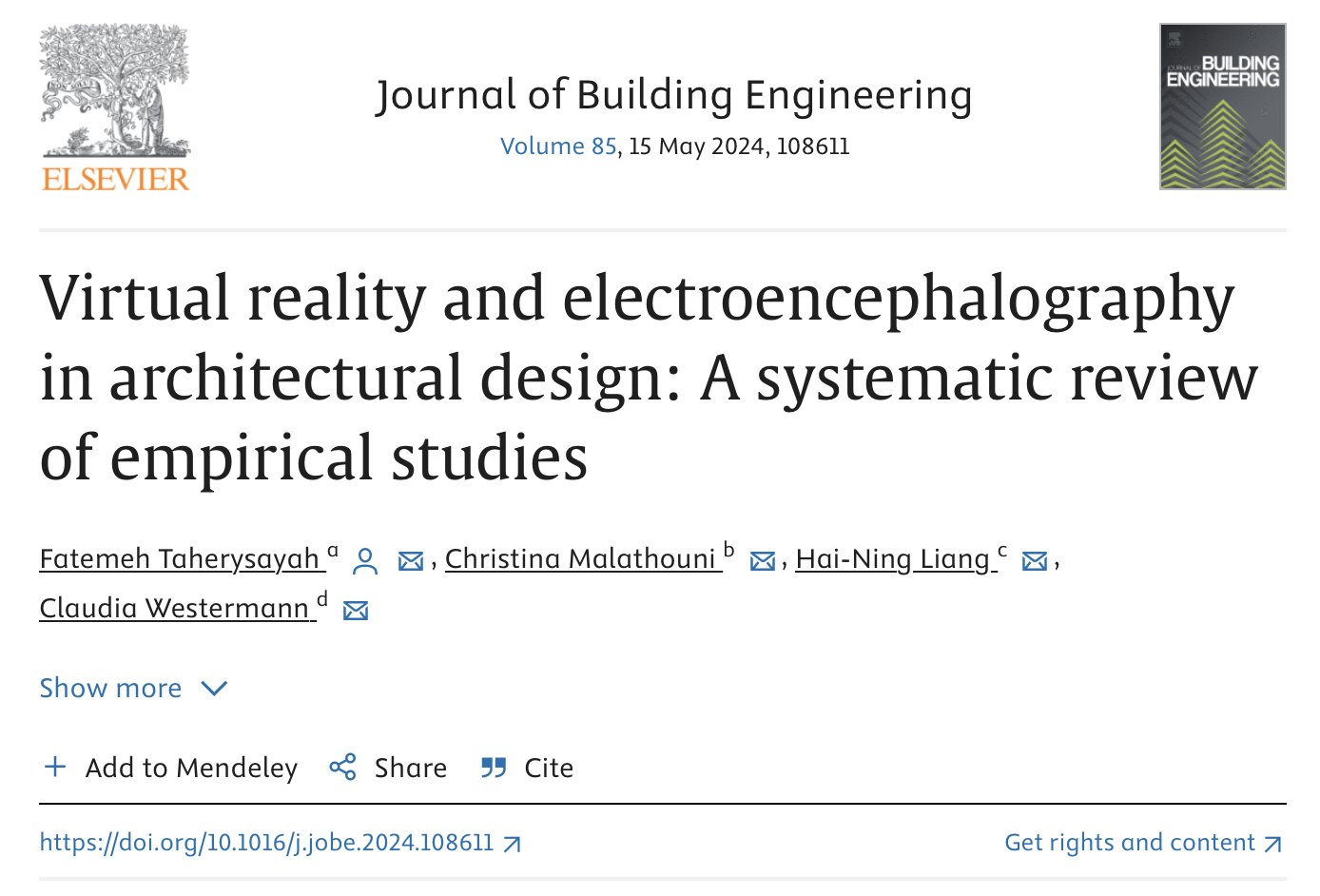
Integrating human needs and desires into the design process has long been a crucial aim of design research. Despite advancements, architectural design still often overlooks the diverse dimensions of human experiences. In this context, the recent development of affordable and mobile brain-imaging devices using electroencephalography (EEG) presents an opportunity for a new approach to human-centered architectural design, especially in combination with virtual reality (VR). Despite existing EEG/VR studies in architecture, a comprehensive review of the methods used to translate EEG data into architectural design is lacking. To address this gap, this article presents a systematic review of empirical studies that use EEG in VR and investigate the impact of designed environments on users. Searches in the databases of Scopus, Web of Science and Science Direct resulted in nineteen articles utilizing both EEG and VR and focusing on an architectural perspective. The data analysis was performed qualitatively and is presented in summary-of-findings tables. The results indicate that in all reviewed studies, the framing environments affect specific brain regions and support different physiological, psychological, and cognitive functions. However, reliable conclusions about the impact spectrum of specific environmental features and associated event-related dynamics require further studies. Several gaps and challenges were identified. These include the need to develop comprehensive strategies for synthesizing data from a variety of sources, considering the distinct effects of familiar and new environments, and addressing limitations posed by sample sizes and demographic diversity. Additionally, long-term studies and investigations of the environmental impact on groups remain areas for future research.
Situating Krippendorff's Critical Cybernetics
by Claudia Westermann
Constructivist Foundations 19 (1): 109-111, 2023. (open access)
This Open Peer Commentary on “A Critical Cybernetics” by Klaus Krippendorff outlines that enacting alternative not-yet existing realities goes beyond discourse and can be considered design practice. A Critical Cybernetics for enacting alternative not-yet existing realities, such as Krippendorff proposed, would benefit from associating itself with the expertise in the technicity of society that has been central to cybernetics since its inception.
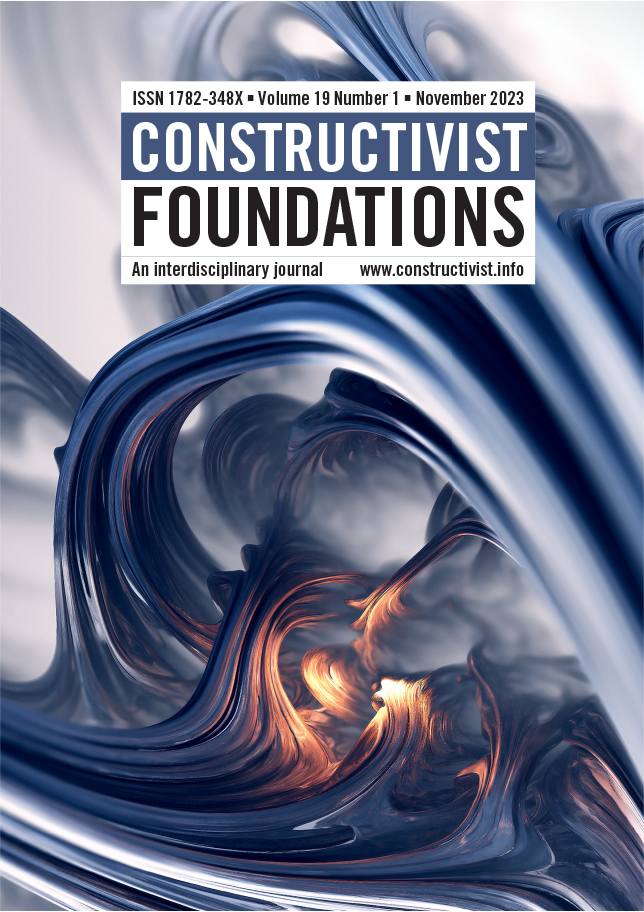
#NewMacy Studio in Sympoiesis
by Claudia Westermann, Ioannis Bardakos, Eryk Salvaggio, Jude Lombardi, and Larry Richards
Relating Systems Thinking and Design (RSD12)
Sympoiesis, a term coined by Beth Dempster and further developed by Donna Haraway, works as a conceptual remedy against misappropriations of autopoiesis. Replacing the prefix auto- with syn- emphasizes interdependence. Sympoiesis, one could say, is what the concept of autopoiesis needs to become when the observation moves from the molecular domain to the domain of living beings. Sympoiesis emphasizes the interdependence of living beings and other living beings, environments, things, concepts, and ideas.
As Larry Richards has outlined, the making of something new—the process of poiesis—requires the suspension of synchronicity. In our Studio, asynchronicity will create the necessary condition for engendering the collision of two distinct phenomenal and logical domains—the domain of relations and the domain of dynamics—and affirm sympoiesis as a cybernetic concept. The #NewMacy Studio in Sympoiesis will be an exercise in the suspension of clock time.
KEYWORDS: second-order cybernetics, sympoiesis, autopoiesis, anticommunication, asynchronicity
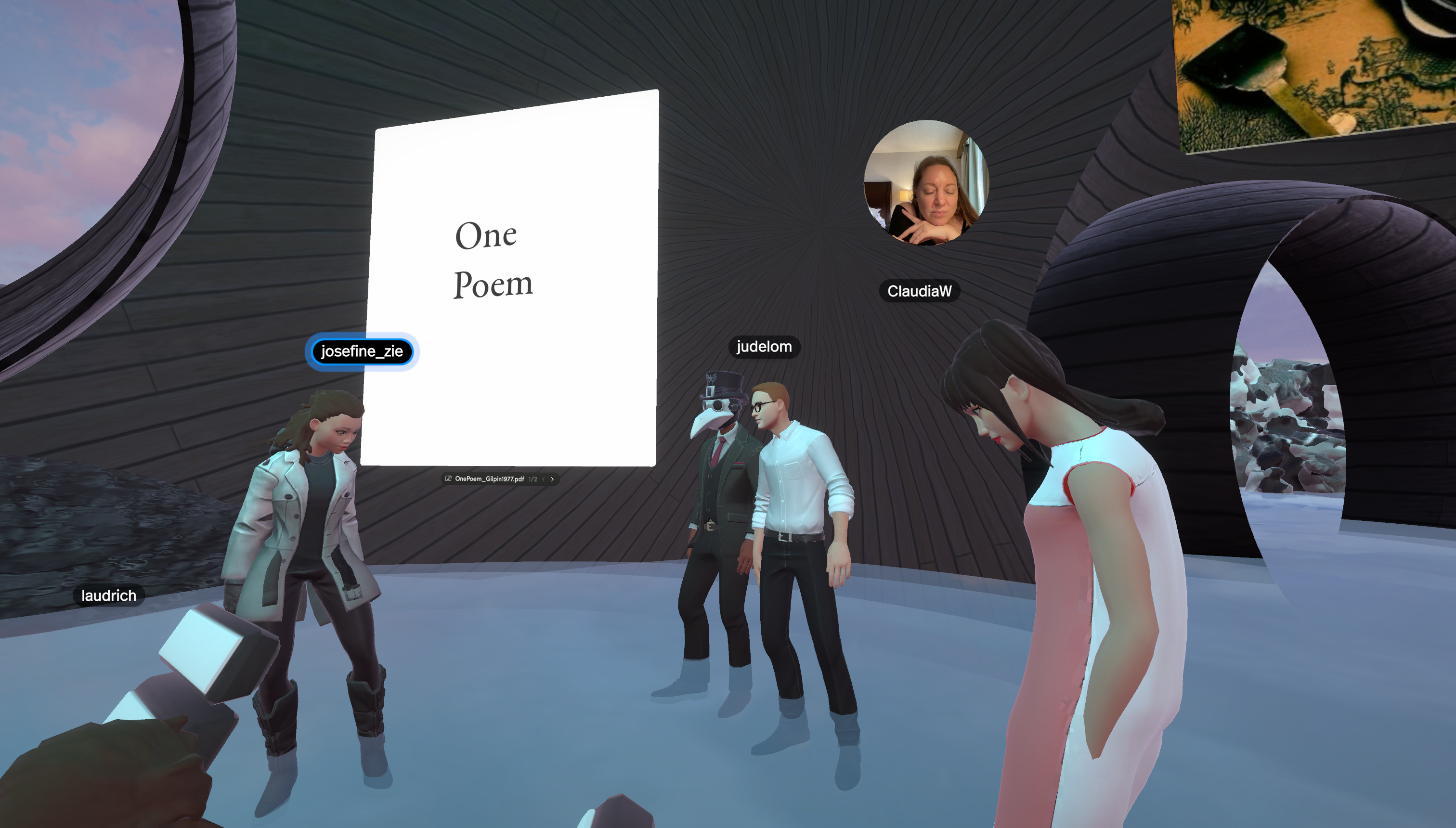
Editorial: Turning queries into questions: For a plurality of perspectives in the age of AI and other frameworks with limited (mind)sets
by Claudia Westermann and Tanu Gupta
Technoetic Arts, Volume 21, Issue 1, Aug 2023, pp. 3–13 (open access)
The editorial introduces issue 21.1 of Technoetic Arts via a critical reflection on the artificial intelligence hype (AI hype) that emerged in 2022. Tracing the history of the critique of Large Language Models, the editorial underscores that the recent calls for slowing down the development of AI, as promoted by the technology industry, do not signify a shift towards reason and considerate economics. Instead, as these calls are firmly embedded in narratives where the power to decide for the majority of humanity lies solely with the CEOs of AI companies, they are indicative of a relentless pursuit of economic interests. The technology industry has consistently downplayed criticism over the years. While patterns of creative output can be replicated without a thorough understanding of underlying concepts, the editorial highlights the distinction between the current AI technology's reliance on extensive pre-existing human-generated data for pattern recognition and the performative process inherent in art practice. This performative process, as explored through the conceptual frameworks of creativity by Noam Chomsky, Charles Sanders Peirce, and Roger T. Ames and with reference to an earlier publication of the editorial's author, continually 'strives to extend itself towards the unknown.' Following this introductory section, the editorial provides an overview of the ten articles featured in this issue of Technoetic Arts. The first four texts engage with emerging technologies from various perspectives in art and design. The subsequent six articles, part of a special section titled 'Perspectives from Chandigarh,' reflect a quest for meaningful existence within colonial, patriarchal, and biopolitical structures that frame everyday practices of exclusion and oppression.
MIT's 5 THINGS NEWSLETTER
The January edition of the 5 THINGS TO THINK ABOUT newsletter of MIT’s Knowledge Futures Group features Technoetic Arts.
These are the five things the Editorial Organism has selected:
1/ The Mask
2/ The Cyborg’s Prosthesis
3/ The Quarantine Fruit
4/ Our Call, Your Voice
5/ The Editors’ Cloud Picnic
Click the image to read the newsletter.
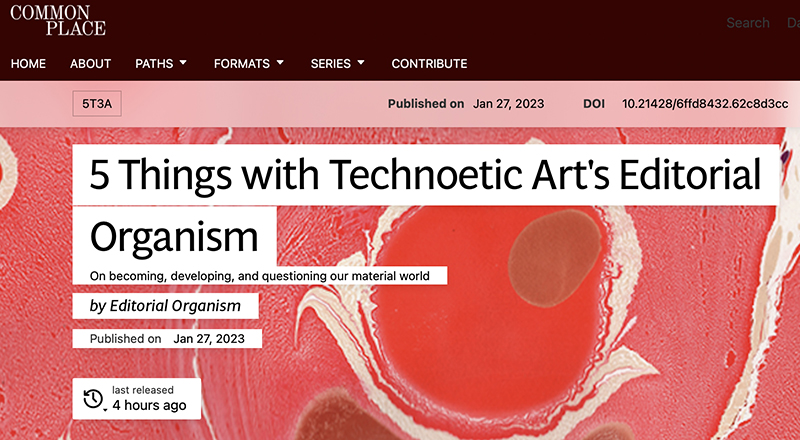
Interview
10 January 2023
Dalila Honorato, Ioannis Bardakos and Claudia Westermann spoke to Sarah Kearns of MIT's Knowledge Futures Group about Technoetic Arts: A Journal of Speculative Research, how to be an Editorial Organism, what cybernetic picnics have to do with it, and why they use the pubpub platform.
Read the interview here: https://help.pubpub.org/pub/f8elek3i/

From Within, or the Domain of Design Practice
by Claudia Westermann
Constructivist Foundations 18 (1): 137-139. 2022. (open access)
Presenting an Open Peer Commentary on “In Maturana’s Wake: The Biology of Cognition’s Legacy and its Prospects” by Randall Whitaker, the article suggests that engaging with Maturana's biology of cognition in the context of design is a form of practice rather than application. Maturana's biology of cognition, the article argues, can be conceived of as initiating an educational process that supports agents to act “from within” rather than “from without.”
Open access. Special Issue <<Humberto Maturana’s Impact on Science and Philosophy: A Plurality of Perspectives>> edited by Alexander Riegler & Pille Bunnell. Target articles by Fritjof Capra, Alexander V. Kravchenko, Nelson Monteiro Vaz, Jorge Mpodozis, and Randall Whitaker.
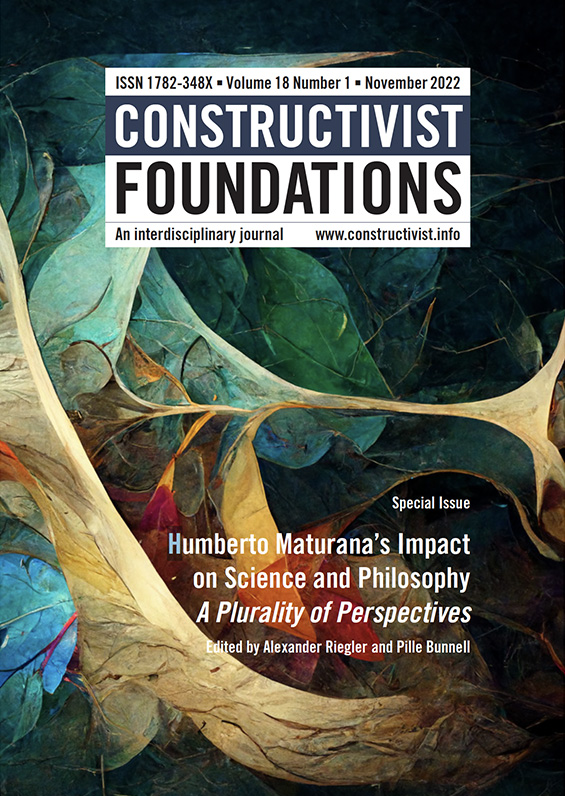
Cybernetic Musings on Open Form(s): Learning to float
by Claudia Westermann
RSD 11: Annual Systemic Design Symposium: Relating Systems Thinking and Design at: https://rsdsymposium.org/cybernetic-musings-on-open-forms
Second-order cybernetics conceives of human beings as agents and participants in the making of worlds, embedded in the design process. This conception of designing as a practice of living with and in a world grants it both urgency and hope.
The paper proposes that design practitioners, in the widest sense, can learn from design cybernetics when conceiving new methodologies for the post-Anthropocene era. Further, it proposes that these methodologies’ development can take advantage of comparative studies of design cybernetics and design strategies found in traditional Chinese culture. Significantly, Chinese landscape poetry and landscape painting, and, in relation to this, Chinese classical garden design, emphasise elements that are also present in cybernetics discourse: circularity, a floating observer, and the continuity of observer and environment. The paper proposes that these ideas create the necessary conditions for the development of design approaches that re-connect human beings to their environments and permit future agents to initiate change from within. It concludes with an example of a public art installation that implements these ideas.

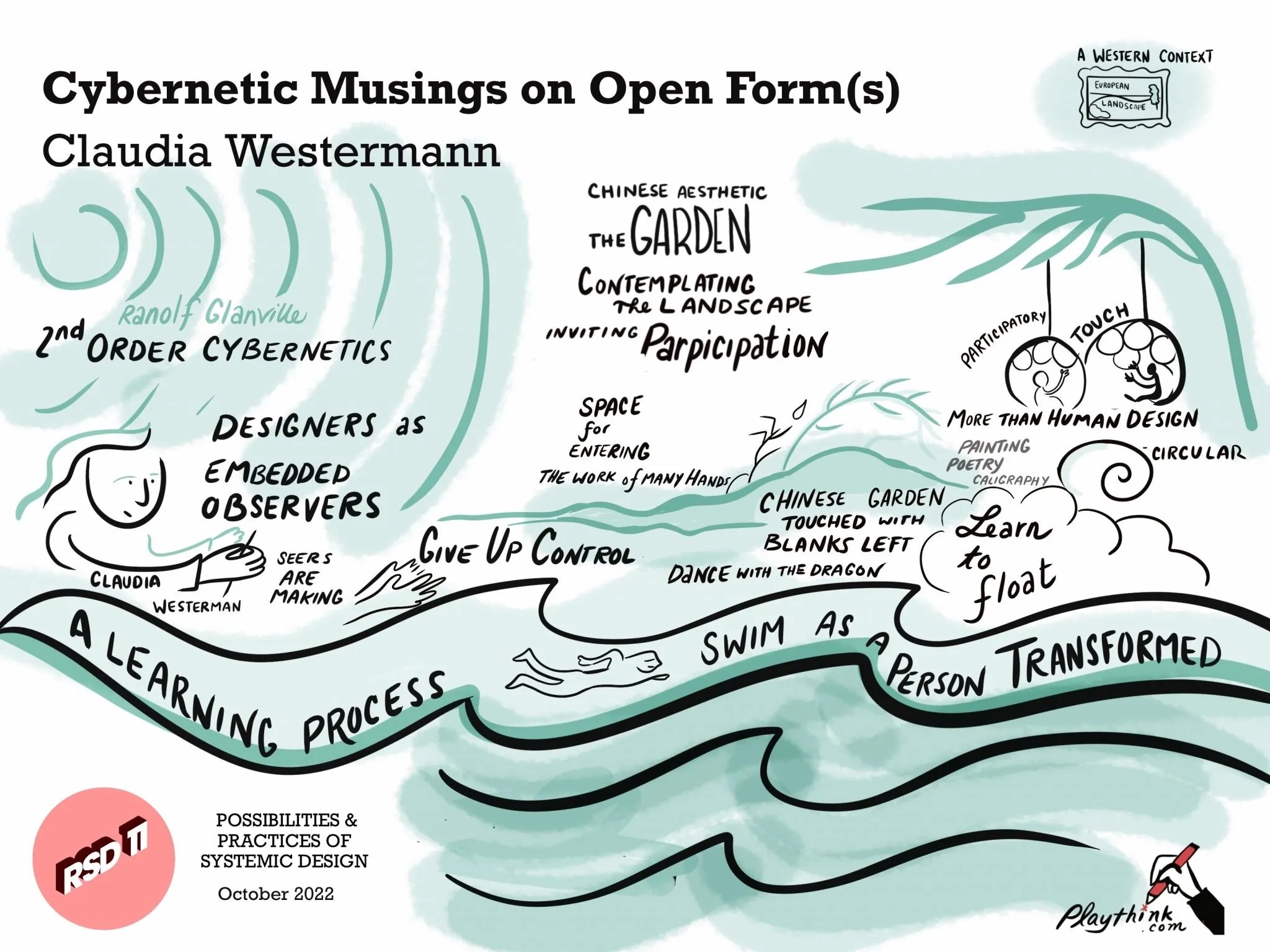
Editorial: On Modes of Participation
by Bardakos, Ioannis, Claudia Jacques, Dalila Honorato, Claudia Westermann, and Primavera de Filippi
Technoetic Arts: A Journal of Speculative Research, 19.3 On Modes of Participation, volume year 2021. https://ta.pubpub.org/pub/19-3-contents-abstracts
On globes, the Earth and the Cybernetics of Grace
by Claudia Westermann
Technoetic Arts: A Journal of Speculative Research, 19(1/2) Global Conversation special issue, pp. 29–47. Published in 2022, volume year 2021. https://doi.org/10.1386/tear_00049_1.
You may use the following link to access the article via the EBSCO subscription of your academic library. Choose the Institutional Login below the blue Sign In button. If you do not have access to an academic library, you may obtain a copy of the preprint via the PhilPapers platform or contact the author for a personal copy of the article.
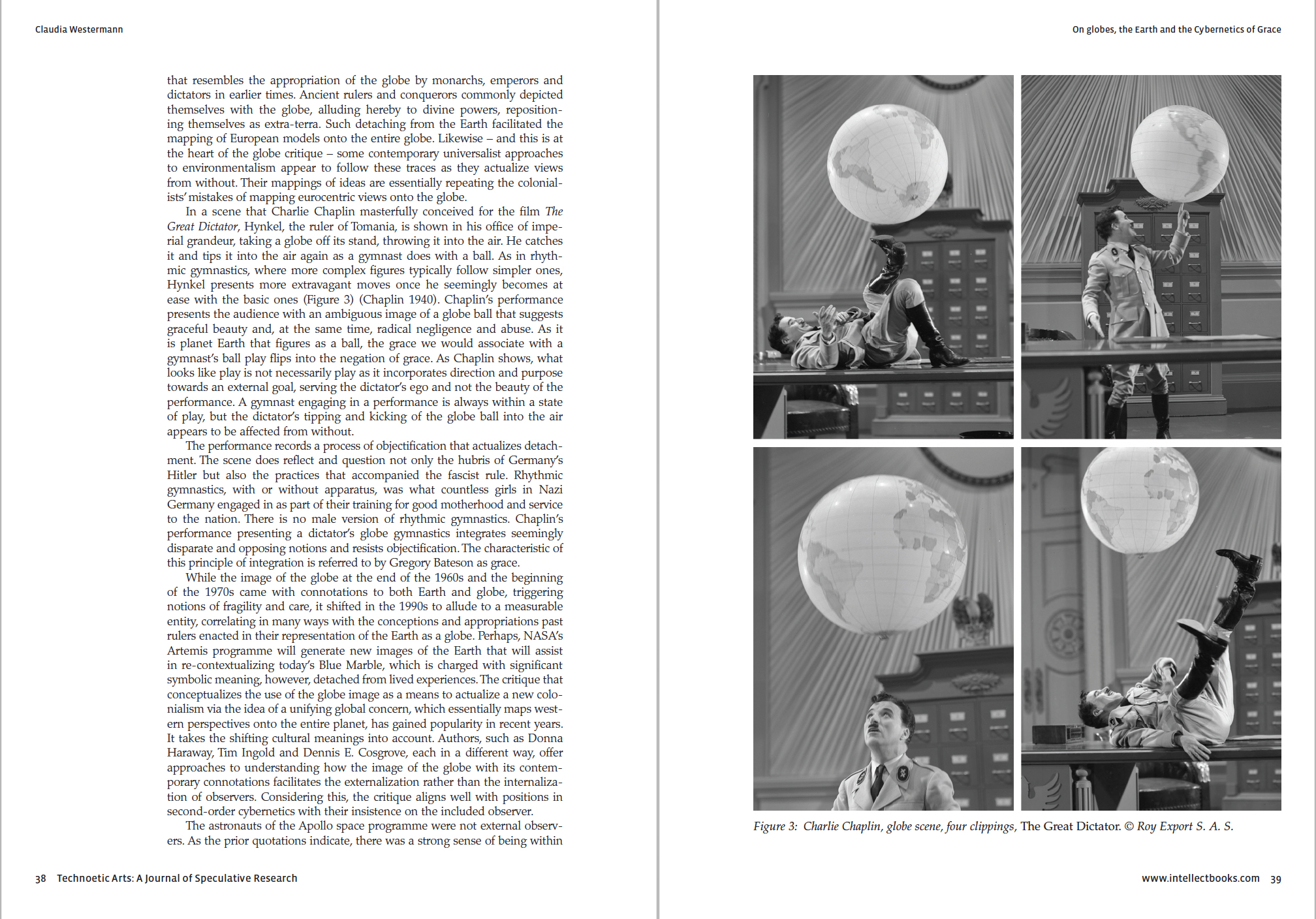
Claudia Westermann, 'On globes, the Earth and the Cybernetics of Grace' (2021); the right page shows clippings from Chaplin's film 'The Great Dictator.'
The article presents an enquiry into conceptions of ‘global’ that began at the American Society for Cybernetics 2020 Global Conversation conference. Following the traces of Margaret Mead’s statement that emphasized that the first photographic images of the Earth from space presented notions of fragility, the article contextualizes the recent critique of the dominant representation of the Earth as a globe that emerged in conjunction with the discourse on the Anthropocene. It analyses the globe as an image and the sentiments that accompanied it since the first photographs of our planet from space were published in 1968. The article outlines how the cultural meaning of the whole Earth representation changed in parallel with the appropriation of the image by the large technological enterprises that emerged from America’s counterculture. It returns to the possibility of a coexistence of ‘views from within’ and ‘views from without’ following a detour with Gregory Bateson via Bali and proposes a Cybernetics of Grace as a practice of resistance against pure exteriority. The article concludes by linking the Cybernetics of Grace with the second-order conversations of Gordon Pask.
A Conversation on a Paradise on Earth in Eight Frames
by Tordis Berstrand, Amir Djalali, Yiping Dong, Jiawen Han, Teresa Hoskyns, Glen Wash Ivanovic, Siti Balkish Roslan, and Claudia Westermann, East Asian Journal of Philosophy, Special issue: Philosophy of the City, vol. 1, no. 3, pp. 95–116. https://doi.org/10.19079/eajp.1.3.95
Once known as the city of silk, Suzhou [苏州] has become the centre of wedding dress production, selling paradise on earth for one day, including copies of the last royal wedding dress, out of shops at the foot of mythic Tiger Hill. Suzhou is also the host of what is known as the Silicon Valley of the East. It has attracted millions of migrants searching for a better future; millions of tourists visit every year to experience the past, strolling through the gardens and courtyards of its Old Town. The contrasts could hardly be more apparent. Slow time, and fast time, and the time of the in-between, are woven into the city’s complex spatial fabric. This is a conversation by eight authors in eight frames on a city that connects them.
Poiesis, Ecology and Embodied Cognition
by Claudia Westermann
July 2021, Technoetic Arts a Journal of Speculative Research 18(1):19–29. http://dx.doi.org/10.1386/tear_00023_1
Since René Descartes famously separated the concepts of body and mind in the seventeenth century, western philosophy and theory have struggled to conceptualize the interconnectedness of minds, bodies, environments and cultures. While environmental psychology and the cognitive sciences have shown that spatial perception is ‘embodied’ and depends on the aforementioned concepts’ interconnectedness, architectural design practice, for example, has rarely incorporated these insights. The article presents research on the epistemological foundations that frame the communication between design theory and practice and juxtaposes it with scientific research on embodied experience. It further suggests that Asian aesthetics, with its long history in conceiving relations and art as interactive, could create a bridge between recent scientific insights and design practice. The article outlines an approach to the interconnectedness of minds, bodies, environments, the sciences and cultures, in favour of a future that is governed by creative wisdom rather than ‘smart’ efficiency.
Due to copyright restrictions, we are not permitted to share the manuscript on this website until July 2022. If you are a student or a researcher you likely have access to the text via your academic library's EBSCOhost subscription. Try this link: https://search.ebscohost.com/login.aspx?direct=true&db=vth&AN=151469195&site=eds-live&scope=site. If it does not work, send Claudia a message. She will be happy to share the text privately.
Featured by the American Society of Landscape Architects as one of the best books of 2020:
New Horizons: Eight Perspectives on Chinese Landscape Architecture Today
edited by Jutta Kehrer
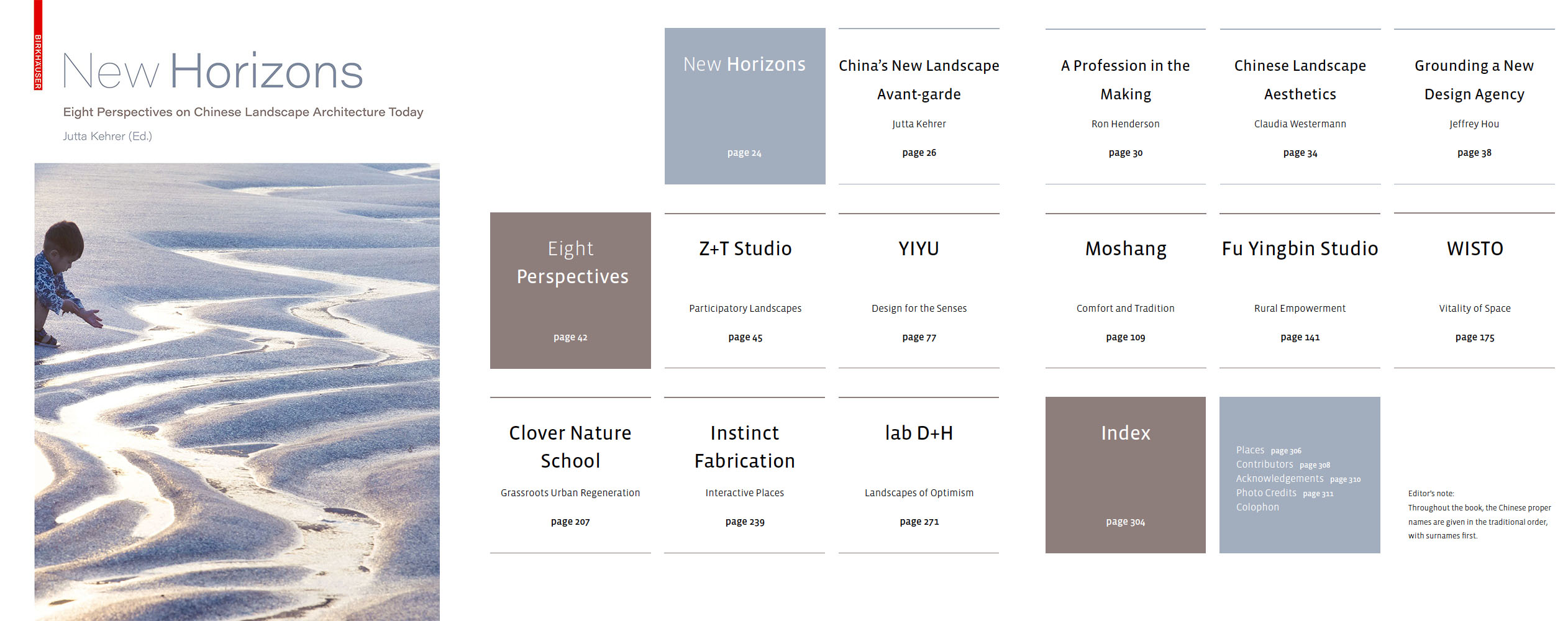
[..] flowing with the waters, halting with the mountains. In the images of light and wind the ephemeral is inscribed. Time is part of space. The scene performs.
The essay "Chinese Landscape Aesthetics: the exchange and nurturing of emotions" by Claudia Westermann included in New Horizons: Eight Perspectives on Chinese Landscape Architecture Today introduces ideas of landscape in traditional Chinese thought. Following the etymology of the Chinese terms for landscape and recognizing that their conceptual focus is on the exchange and nurturing of emotions, which is not captured by the English term 'landscape,' one may gain a new understanding of contemporary works of Chinese landscape architecture.
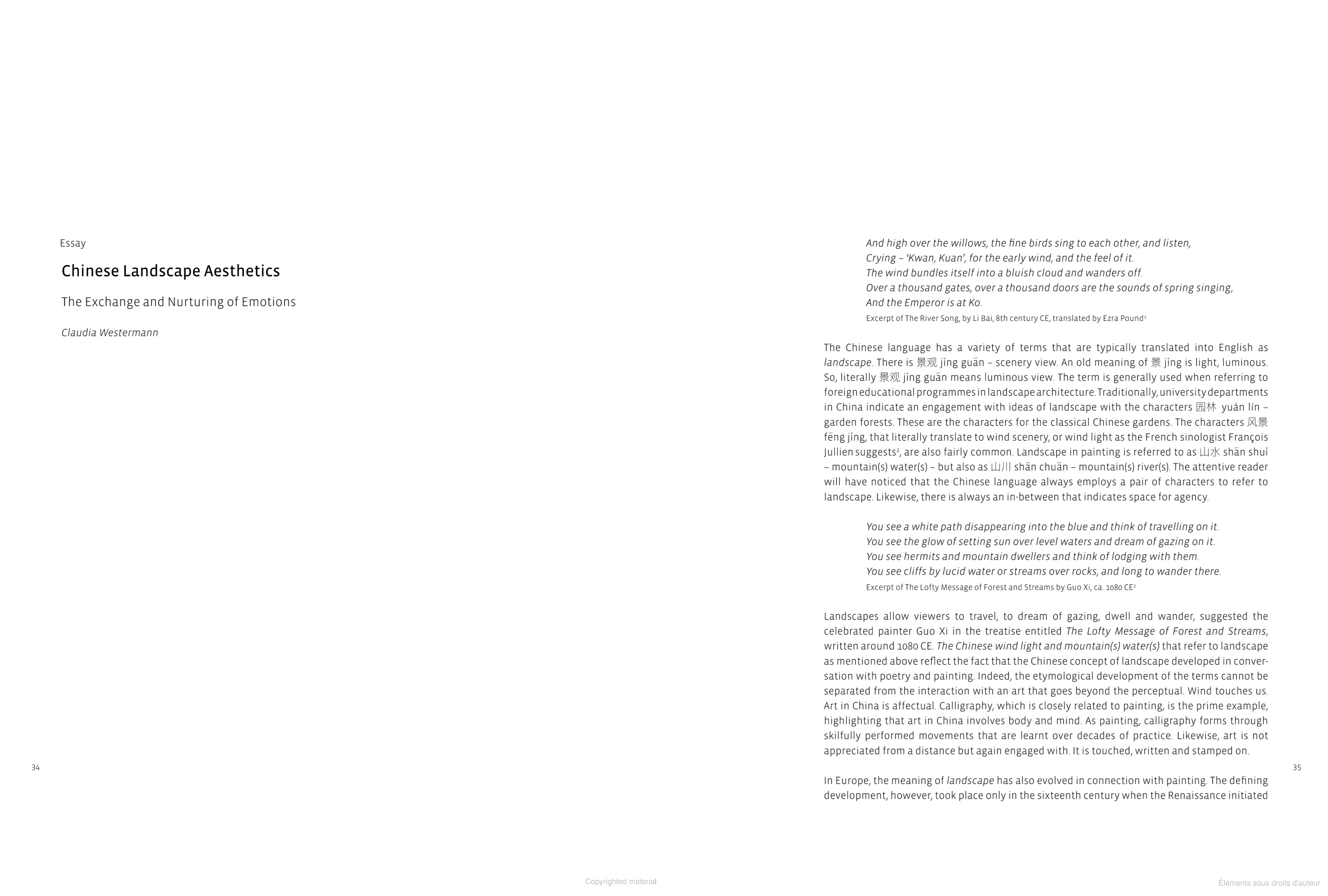
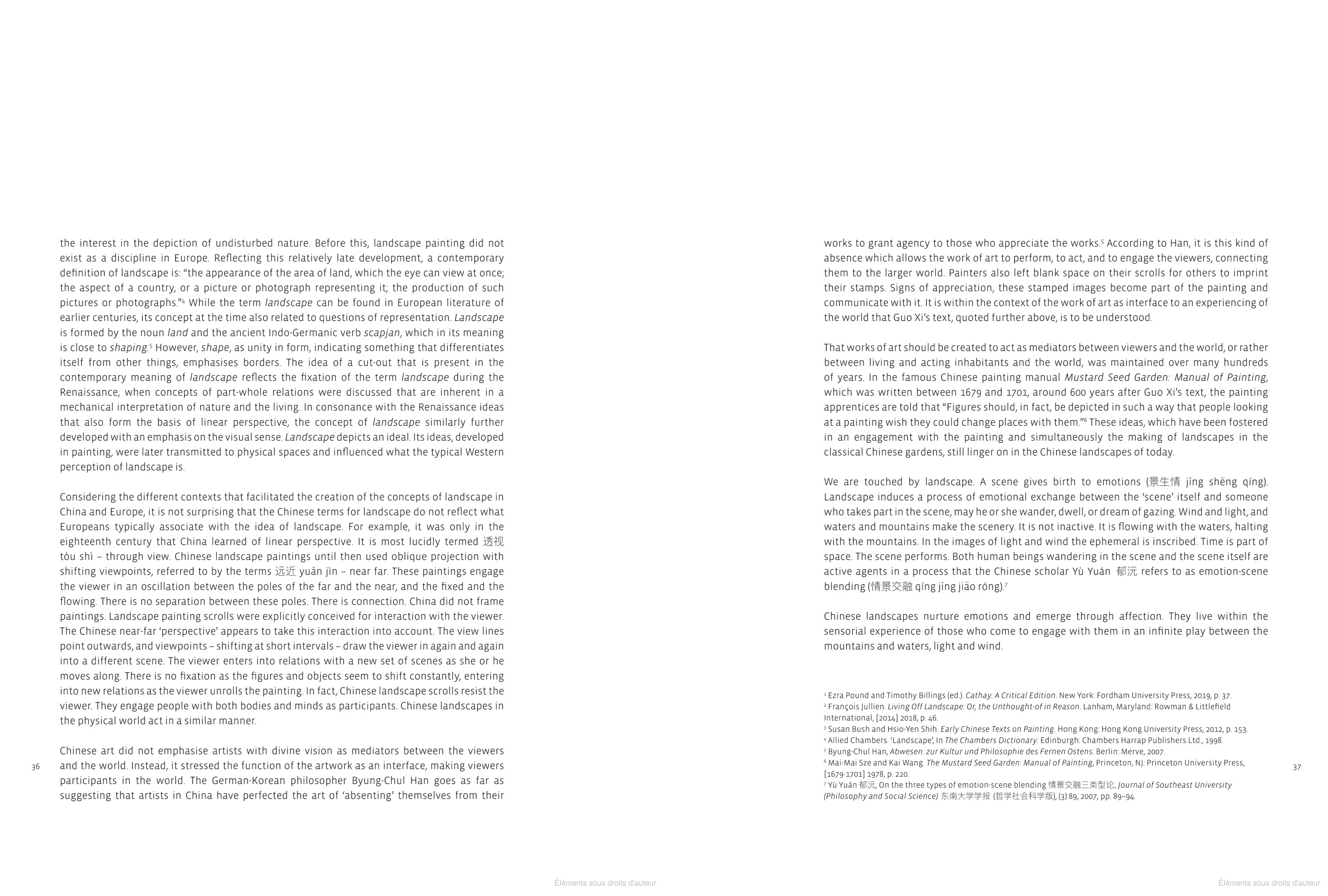
The (very short) essay "Chinese Landscape Aesthetics: the exchange and nurturing of emotions" by Claudia Westermann of LITRA can also be accessed via google books. The author's manuscript is available for download from this server.
The Art of Conversation | Design Cybernetics and its Ethics
The art of conversation: design cybernetics and its ethics was published in 2020 in Kybernetes. The manuscript is available from researchgate, and from this server.
Concerned with questions of ethics in design, the paper highlights second-order design cybernetics as an approach to design that has inscribed in its conception a radical openness toward the future and the agency of others. Design Cybernetics, the paper argues, creates a suitable frame of reference for conceiving social systems of all kinds, including environments that are designed to be inhabited. The second-order conception of art of Gordon Pask, his collaborators, and pupils, can be seen to follow John Dewey's 'grounding' of art in experience. Its focus, however, is slightly different, as it emphasises the capacity of art to open an intersubjective space.
The paper identifies an aesthetics grounded in the process of living-with-others as an ethical principle implicit in second-order cybernetics thought. It is an aesthetics that is radically open for the agency of others. The interconnection of aesthetics and ethics in the second-order cybernetic conception of art and design is unique and has not yet sufficiently been highlighted. Linking aesthetics and ethics, the paper's contributions are of specific value for practitioners and theoreticians of design.
The article may contribute to a better understanding of how second-order cybernetics provides for unique, so far overlooked, opportunities for re-thinking design research, aesthetics and the philosophy of art.
Poetics of Designing, in: Design Cybernetics | Navigating the New
edited by Thomas Fischer and Christiane M. Herr, published by Springer in 2019.
You might have access to the ebook via your academic library's Springer Link subscription. https://link.springer.com/book/10.1007%2F978-3-030-18557-2 (Log in via Shibboleth or Athens). The author's manuscript of the chapter 'A Poetics of Designing' is available for download from this server.
The chapter provides an overview on what it means to be in a world that is uncertain, e.g., how under conditions of limited understanding any activity is an activity that designs and constructs, and how designing objects, spaces, and situations relates to the (designed) meta-world of second-order cybernetics. Designers require a framework that is open, but one that supplies ethical guidance when ‘constructing’ something new. Relating second-order design thinking to insights in philosophy and aesthetics, the chapter argues that second-order cybernetics provides a response to this ethical challenge and essentially it entails a poetics of designing.
'A Poetics of Designing' is part of the first book-length collection of texts in Design Cybernetics. It introduces the subject from the point of view of aesthetics. Importantly, the chapter argues that second-order cybernetics circumvents the necessity for a muse inspired artist or genius as a mediator between higher spirits and life, in favour of artists and designers who have true agency.
Cybernetics is often associated with AI, which is, however, only one of the branches that developed on the basis of the interdisciplinary research begun in the 1940s and entitled cybernetics. The chapter may contribute to a better understanding of the second-order cybernetics that has been conceived in close relationship with art and design from the late 60s onwards.
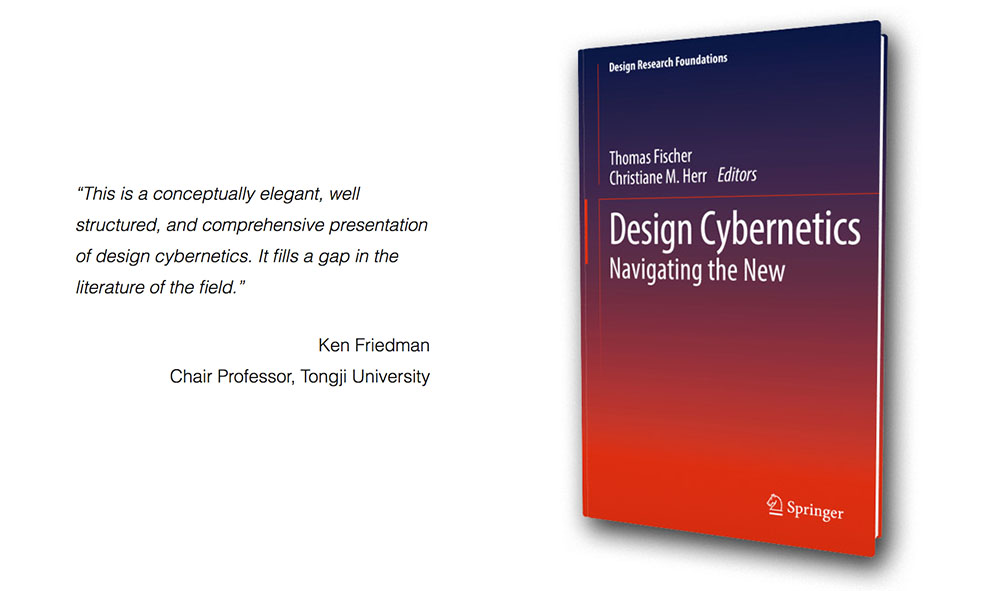
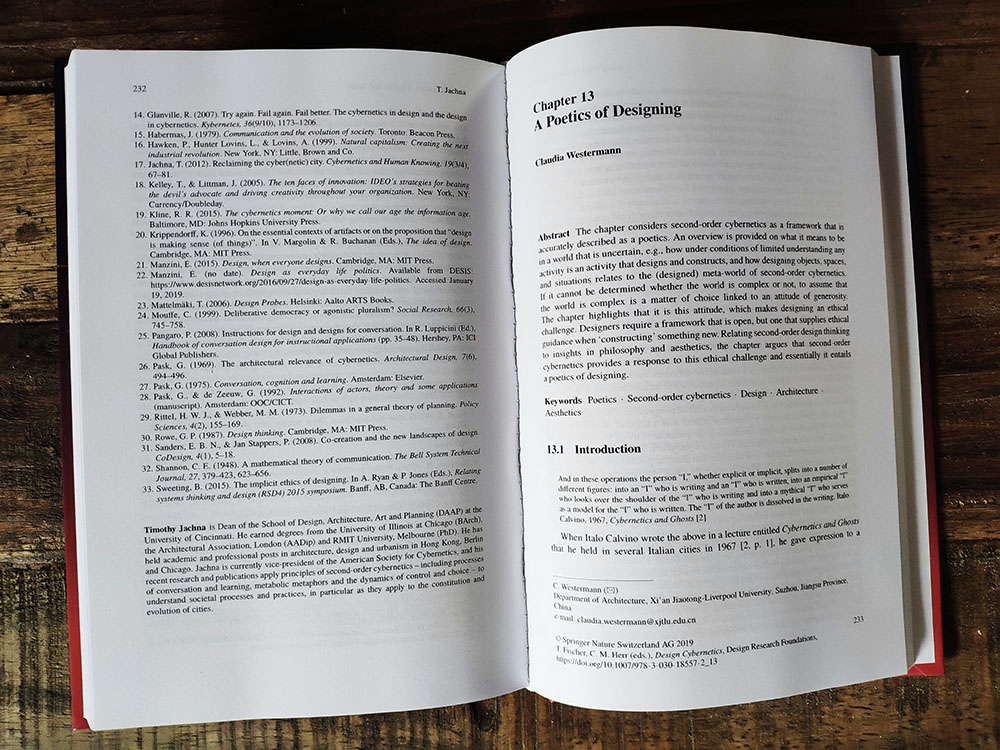
The conference papers An eco-poetic approach to architecture across boundaries and Constructing the Hybrid City: Shanghai were published open access in 2019 and 2020 respectively and may be obtained via the links underlying the above titles. The manuscript of the paper On delight: Thoughts for tomorrow published in 2018 in Technoetic Arts may also be obtained from researchgate.